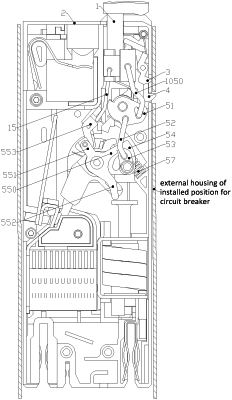| CPC H01H 71/58 (2013.01) [H01H 9/20 (2013.01); H01H 71/0207 (2013.01); H01H 71/1009 (2013.01)] | 10 Claims |

|
1. A miniature circuit breaker, comprising:
a button mechanism,
a circuit breaker housing, and
an anti-switching-on mechanism,
wherein the button mechanism is arranged at one end of the circuit breaker housing and is in sliding fit with the circuit breaker housing, the anti-switching-on mechanism comprises a first locking member, the first locking member is pivotally arranged on the circuit breaker housing, one end of the first locking member is in locking fit with the button mechanism to prevent the button mechanism from moving towards a switching-on direction, and after the miniature circuit breaker is installed in place to an installed position for the circuit breaker, an external housing of the installed position for the circuit breaker acts on the first locking member, so that after the first locking member is unlocked from the button mechanism, the button mechanism is capable of moving towards the switching-on direction for a switching-on operation; and
wherein the button mechanism comprises a button head, a button body, and a first connecting rod, the button head is located on one side of the button body for a user to operate the button mechanism, the first connecting rod is in transmission connection with the button body, one end of the first connecting rod is inserted into the button body, the other end of the first connecting rod is connected with an operating mechanism, the first locking member is in locking fit with the first connecting rod, which prevents the button mechanism from moving towards the switching-on direction, and when the anti-switching-on mechanism is unlocked from the first connecting rod, the button mechanism is capable of moving towards the switching-on direction and performing the switching-on operation, the button mechanism drives the operating mechanism to act through the first connecting rod, thus connecting a moving contact with a static contact.
|